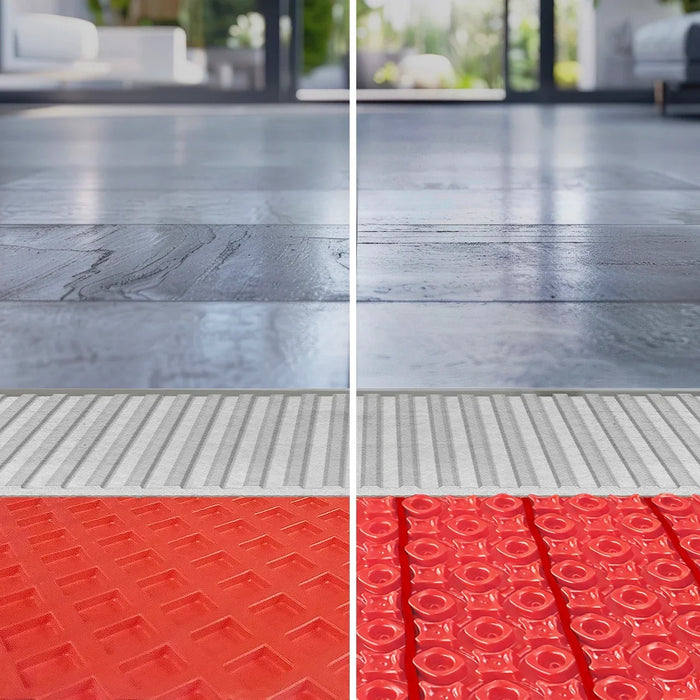
(502) 783-7995
(502) 783-7995


Electric underfloor heating has become a popular choice for homeowners that want an efficient and comfortable way to heat their homes. This modern heated floor mat solution provides uniform warmth, reduces energy consumption, and eliminates the need for radiators, giving you more freedom in your interior design.
However, when it comes to installing electric underfloor heating, homeowners face an important decision: should they tackle the installation themselves or hire a professional? Understanding the processes, benefits, and drawbacks of each option can help you make an informed choice. In this article we will discuss DIY vs. professional underfloor heating installation.
Installing electric underfloor heating yourself can be a rewarding project, particularly if you enjoy hands-on home improvement tasks.
The DIY process typically involves several steps, starting with measuring and preparing the floor. You’ll need to make sure that the subfloor is clean, level, and free of any sharp objects that could damage the heating elements.
Next, an insulation layer can be laid to maximize the efficiency of the system by reducing downward heat loss and reflecting heat upwards. Insulation is particularly beneficial when installing floor heating on concrete sub-floors.
The heating mats or cables are then rolled out or laid in a serpentine pattern according to the manufacturer's instructions. It's crucial to follow the layout plan precisely to ensure even heat distribution.
Once the heating cables or mats have been covered with a levelling or self-levelling compound the floor covering can be installed, make sure to follow manufacturers guides on testing throughout the process.
Finaly, the underfloor heating cables or mats can be connected to the floor heating thermostat, this step requires a qualified electrician. Do not energize the heating mats until the floor is complete.
One of the main advantages of DIY installation is cost savings. By doing the work yourself, you can significantly reduce labor costs, making electric underfloor heating more affordable. Also, the satisfaction of completing a home improvement project on your own can be immensely rewarding.
However, DIY installation also comes with several risks and challenges. First and foremost, improper installation can lead to inefficient heating, increased energy consumption, or even damage to the heating system.
Electrical work, in particular, poses safety risks if not done correctly. Homeowners must also consider the time commitment and potential for mistakes, which could end up costing more in the long run if professional help is needed to correct errors.
Hiring a professional to install your electric underfloor heating system offers a different set of advantages. Professional installers typically begin with a thorough assessment of your home. They will check that the subfloor is properly prepared and that the insulation is installed correctly to maximize its efficiency.
A huge benefit of professional installation is the expertise and experience that professionals bring to the job. They can confirm that the heating elements are laid out perfectly for optimal heat distribution and that all electrical connections are made safely and in compliance with local codes.
Professionals also have access to specialized tools and materials that can make the installation process less prone to errors.
Once the heating system is installed, professionals can also offer guidance on the best type of floor covering to use and see that it is installed correctly. This skilled approach reduces the risk of damage to the heating system and ensures that it works properly from the start.
The biggest advantage of professional installation is the peace of mind it provides. Knowing that your electric underfloor heating system has been installed correctly and safely by an expert can be invaluable. Professionals also often offer warranties on their work, providing additional security.
On the downside, professional installation can be expensive. Labor costs can add significantly to the overall expense of the project, which might be a deterrent for budget-conscious homeowners.
However, this cost is often offset by the long-term benefits of a properly installed system, which can include lower energy bills and fewer maintenance issues.
Deciding between DIY and professional installation depends largely on your skills, budget, and priorities. For experienced DIY enthusiasts with a good understanding of electrical systems, installing electric underfloor heating can be a manageable and cost-effective project. It’s also a good option for smaller areas, where the risk and complexity are reduced.
On the other hand, for those with limited DIY experience or those installing heating systems in large or critical areas, hiring a professional is likely the best choice. The initial investment in professional installation can save you time, stress, and potential costly mistakes. For homeowners who value peace of mind and long-term reliability, professional installation is often the preferable option.
Both DIY and professional installation of electric underfloor heating have their merits. Carefully consider your own abilities, the scope of your project, and your budget to make the best decision for your home. Whether you choose to go it alone or enlist the help of a professional, electric underfloor heating can transform your home’s comfort and efficiency for years to come.

Our under floor heating experts will work on the design and layout of your project, for free!